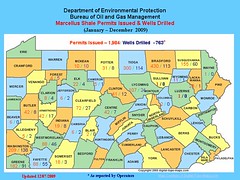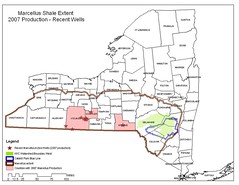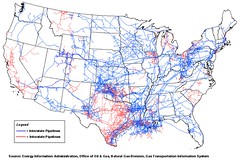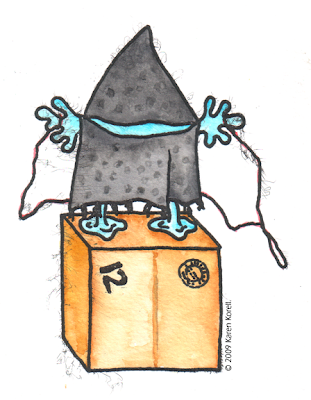by Nastassja Noell | 09.28.2009
originally published at:
http://www.phillyimc.org/en/natural-gas-drilling-threatens-communities-northeastern-united-states
Natural Gas Drilling is forcing residents in West Virginia to put spikes in the roads to stop drilling trucks from destroying their land, water, and air. In Pennsylvania rural folks are trespassing in order to document toxic natural gas production waste spills. New York City, Washington DC, Philadelphia's drinking water are at risk of contamination.
This week while protesters at the G-20 are getting beaten by police and soaking their bandannas in vinegar to protect their lungs from tear gas,
some folks in neighboring counties and states are putting spikes in roads to stop the drilling trucks, and taking down street signs so that truck drivers can't find their way to drilling sites. Others are documenting ecological devastation, and raising their voices in unison against the officials who purport to protect them.
In Pennsylvania, Ohio, West Virginia, and New York folks struggle with local officials and corporate media, bringing national attention to the victims of peak-energy's destructive frenzy. Numerous incidents involving road accidents, water contamination, and unresponsive government officials have pushed Pittsburgh's neighbors in Wetzel County, West Virginia to place spike strips along RT 89, a road heavily trafficked by Chesapeake Energy's trucks traveling to drilling sites. (1)
"They ruined my life and they've created a new world for you to deal with" said Ron Gulla, a rural resident who lives about 30 miles from Pittsburgh. Mr. Gulla has been speaking at meetings throughout the region, helping landowners make informed decisions before leasing their land to natural gas companies. "This is the defense of your life and property, we're fighting for our f#cking lives!"
The Marcellus Shale is a fossil fuel rich rock bed that ranges from the middle of Ohio east to the Catskill Mountains, from upstate New York down south through Kentucky. Drilling waste water may contaminate the drinking water of New York City, Washington D.C., and Philadelphia. Officials in New York City have been pushing legislation to ban natural gas drilling in the Catskill Mountains, which feed the city's drinking water reservoirs. Washington DC gets its drinking water from the Potomac River, whose tributaries are threatened by the toxic liquid wastes produced during natural gas drilling.
The oil and gas industry calls the Marcellus Shale an "unconventional natural gas source"; mining this area was uneconomical until this decade, where the price of oil has been skyrocketing. The Marcellus Shale is the 3rd largest natural gas field in the world, expected to generate enough natural gas for 2 to 10 years of US consumption. The process is being advertised as a local clean energy source, bringing in jobs and economic growth. The mining of the Marcellus Shale is projected to continue to pollute the soil, streams and aquifers in the Northeastern United States for 5 to 30 years. After the Marcellus is depleted, oil companies will work on the Utica Shale, which rests thousands of feet beneath the Marcellus.
Natural gas drilling waste water -- which includes radium, uranium, mercury, and lead -- is suspected to be responsible for the deaths of the 161 species of life which were found killed along 38 miles of Dunkard Creek in Pennsylvania.(2) The Natural Resource Defense Council has reported that livestock have been dying after drinking drilling waste water.(3) The Oil and Natural Gas Industries are officially exempt from the Safe Drinking Water Act, the Clean Air Act, the Clean Water Act, the Emergency Planning and Community Right to Know Act, the Natural Resource Recovery Act and other federal regulations.(4) These exemptions have made the federal government complicit in Coloradan Laura Amos's adrenal cancer(5), and Pennsylvanian Pat Farnelli and her children's violent stomach pains and diarrhea.(6)(7) Benzene and radioactive waste from a WWII military dumping site are suspected of having caused a childhood cancer cluster in Clyde, Ohio, torturing 20 children(8); these toxic contaminants are also produced as wastes during natural gas production(9) and stored in open pits on drilling sites.(10)
At the center of the struggle is the new process of natural gas drilling called horizontal hydrofracking, also known as "fracking."
Natural gas production in the Marcellus Shale involve two stages which each introduce toxic contaminants into our environment. Producers must first drill the well and then they "frack" the well. The first process, drilling, dredges uranium, radium, mercury, and lead laden shale rocks to the surface (11) to make way for a pipe used in the fracking process. These toxic shale materials are stored in open pits on the site for long periods of time, and the liquid wastes are eventually brought to municipal water treatment plants for filtration. Municipal water treatment plants are already so overburdened and unable to filter out toxins from our drinking water that on September 12, the New York Times reported "the nation’s water does not meet public health goals, and enforcement of water pollution laws is unacceptably low."(12)
The second stage of natural gas production, the "fracking" process, is very expensive: each fracking job requires 2-9 million of gallons of water to be extracted from local water sources and creates 1-4 million gallons of toxic liquid waste, which must be brought to a hazardous waste dump or extensively filtered before entering the public watersheds.(13) This amount of waste is generated numerous times per well, as each well can be fracked up to 10 times. The Pennsylvania Department of Environmental Protection allows 800,000 gallons to be taken from Cross Creek Lake every day; Range Resources, a Texas based oil and natural gas company, is the recipient of that permit.(14) This wednesday, Sept. 30 at 7pm, a public hearing in Williamsport , PA will be held for a waste water treatment facility requesting permission to pump 400,000 gallons of minimally treated drilling waste water *every day* into the Susquehanna River.(15)
Throughout the nation State Parks and Public Schools have leased their mineral rights to oil and gas companies in an attempt to balance budgets.(16) And this school year, kids at Elk Lake School in Dimock, PA may get to play in radioactive sludge during recess.(17)
Residents throughout the nation have complained that their wells, soils and streams have been contaminated with the heavy metals and radioactive tailings dredged up from the shale along with the gas.(18) The numerous chemicals used in the fracking process are also a concern. As the natural gas is pumped away from the site through pipelines, the hazardous fracking waste fluids are usually stored on site in open pits for long periods of time.(19) These open pits are often only 100 ft from a persons home or a creek or critical migration corridor, and are sometimes surrounded by a flimsy 3 foot high plastic fencing in a feeble attempt to protect the kids, dogs, livestock, wildlife, and downwind neighbors from the toxins.(20)
Some citizens have been concerned that workers may be poking holes into the plastic sheets that line the bottom of the liquid waste pits, allowing the liquids to drain into the soil and saving the company the expense of disposal at expensive hazardous waste facilities. A landowner told Indymedia that he has watched the levels in waste water pits steadily decrease after they were filled up. In Garfield County, Colorado, a resident videotaped bulldozers burying liquid waste pits with soil, the videotaper reported that the natural gas company Encana owns that drilling pad.(21) Hundreds of miles north of this contamination site, two of Encana's natural gas pipelines were bombed, distraught Canadian citizens are suspected to be responsible.(22)
Recently, residents in Dimock, Pennsylvania were able to voice enough concern to get the Pennsylvania Department of Environmental Protection (DEP) to temporarily stop fracking activities by Cabot, a natural gas producing company that has been spilling toxins into wetlands and a creek.(23) Cabot's fracking activities will be halted for two weeks, but the company may still drill and bore holes for pipelines through wetland areas. Cabot's drilling activities underneath wetlands has been a source of contention for citizen groups due to documented footage of bentonite spills along Cabot's Cranberry Pipeline, a pipeline which currently is being horizontally drilled underneath a wetlands area in Susquehanna County.(24)
Pennsylvania DEP's oil and gas investigation unit is understaffed, and individual citizens are having to monitor drilling activities. Craig Lobins, DEP Northwest Regional Manager for the Oil and Gas Program recently explained to citizens at a meeting in Forest City, PA how the department is unable to fully monitor all drilling sites:
"Lets be realistic about it, they drill 24-7, and I don't think anyone expects someone to stand on a rig 24 hours a day 7 days a week." Mr.Lobins explained to the crowd of over 100 concerned citizens who attended the meeting hosted by the group R.E.S.C.U.E. " And if we did expect them to stand there all day, imagine how expensive that would be."(25)
At a meeting of the Oil and Gas Advisory Technical Board on October 30 of 2008, official notes state that Mr. Lobins "expressed the need for more Oil and Gas Inspectors. He said even if there is no projected increase in permitting, DEP is still understaffed in this area."(26)
But, when Mr. Lobins was asked at the recent Forest City meeting on Sept 16, if he supported a moratorium on drilling until the DEP had enough staff and local oversight of drilling activity, he responded "No." Instead of hiring more investigators, Lobins told the citizens at the Forest City meeting that local residents should be "the eyes of the DEP". Citizens who followed Mr. Lobins suggestion were subsequently told by agents of the DEP that they can't be trespassing onto gas leased land to monitor these sites for illegal activity.
Joanne Fiorito, acting as the eyes of the DEP, recently discovered a waste spill at a drilling site just off RT 29 and upon reporting the spill was warned not to trespass. "If the DEP can't monitor these sites on their own," said Ms. Joanne Fiorito "and then the DEP tells us that we cannot trespass after we found a spill on the Grimsley well pad site that wasn't reported to the DEP by Cabot, well then, where does this leave the citizens of PA who are dependent on the DEP doing its job? It has gotten to the point where I and others will have to do it ourselves, and I personally don't care if they arrest me for civil disobedience, because this land, air and water is what keeps us all alive."
Vera Scroggins, 58, a public broadcast reporter for Binghamton's Open2Everyone TV filmed the Grimsley well pad site discovery spill as well as Cabot's Cranberry Pipeline's bentonite spills with Ms. Fiorito. Her video will be broadcast in the Binghamton, NY region on Channel 4 on September 28 and October 5, 2009. You can request a copy for your local public broadcast channel by contacting Open 2 Everyone TV Binghamton <<
O2ETV.info@gmail.com >>.
The following states are threatened by natural gas drilling: AL, AK, CO, FL, ID, IL, IN, KY, KS, LA, MI, MO, MT, ND, NM, NY ,OH, OK, PA, UT, TX, WV, WY, VA...
CONTACT THESE GROUPS FOR MORE INFORMATION ON HOW TO HELP:
EarthJustice
Clean Water Action
Susquehanna Citizens for Clean Water
Binghamton Regional Sustainability Coalition
Damascus Citizens for Sustainability
Chesapeake Bay Foundation
R.E.S.C.U.E.
ShaleShock and the Listening Project
Allegheny Defense Project
SOURCES:
(1) Chesapeake Energy reports that citizens in Wetzel County, West Virginia have placed spikes along RT 89 --
http://www.wcag-wv.org/S/Safety/SpikeStrip.htm
(2) Pittsburgh Post Gazette reports that 161 species found killed along 38 miles of Dunkard Creek -- "Sudden death of ecosystem ravages long creek 'Everything is being killed': 161 aquatic species have died along Dunkard Creek" by Don Hopey, Pittsburgh Post-Gazette; September 20, 2009.
http://www.post-gazette.com/pg/09263/999458-113.stm
(3) NRDC states that there have reported deaths of livestock may be associated with drilling waste -- "Are Gas & Oil Operations Harming Livestock?" By the Natural Resources Defense Council, May 06, 2009.
http://www.opposingviews.com/articles/opinion-are-gas-oil-operations-harming-livestock(4) Oil and Natural Gas Industries are officially exempt from many federal regulations protecting water, air, and communities, these exemptions listed and explained -- "Free Pass for Oil and Gas: Environmental Protections Rolled Back as Western Drilling Surges: Oil and Gas Industry Exemptions" by The Environmental Working Group; March 26, 2009.
http://www.ewg.org/reports/Free-Pass-for-Oil-and-Gas/Oil-and-Gas-Industry-Exemptions(5) Laura Amos gets adrenal cancer from EnCana contaminating her drinking water with 2-BE -- "Family's water well was contaminated after hydraulic fracturing near their home" by Laura Amos; EarthWorks Action.
http://www.earthworksaction.org/cvLauraAmos.cfm
(6) Pat Farnelli and her children suffer from contamination of their drinking water -- "U.S. energy future hits snag in rural Pennsylvania" by Jon Hurtle, Reuters; March 13, 2009.
http://www.reuters.com/article/domesticNews/idUSTRE52C07920090313(7) Pat Farnelli's drinking water is contaminated and there is a the drilling rig in her backyard -- "Officials in Three States Pin Water Woes on Gas Drilling" byAbrahm Lustgarten, ProPublica; April 26, 2009.
http://www.propublica.org/feature/officials-in-three-states-pin-water-woes-on-gas-drilling-426(8) 20 children in Clyde, Ohio tortured -- "Questions outweigh clues to cancer cluster in Clyde: 20 of the town's children fall ill over the last 8 years" by Tom Henry, Toledo Blade; February 1, 2009.
http://toledoblade.com/apps/pbcs.dll/article?AID=/20090201/NEWS16/902010302/-1/NEWS24(9) Toxins in natural gas production waste pits include benzene, uranium, radium, mercury, lead, toulene, and other carcinogens -- "Chemicals in Natural Gas Production: Pit Chemicals" by The Endocrine Disruption Exchange; November 15, 2007.
http://www.endocrinedisruption.com/chemicals.pits.php
(10) Drilling waste fluids in open pits in Texas;
http://txsharon.blogspot.com/2008/07/more-barnett-shale-sludge-pond.html(11) Uranium, Radium, Lead and Mercury are brought to the surface during drilling of the Marcellus Shale -- "Shale Gas: Focus on the Marcellus Shale" by LisaSumi for the Oil and Gas Accountability Project/Earthworks; May 2008.
http://www.earthworksaction.org/pubs/OGAPMarcellusShaleReport-6-12-08.pdf(12) New York Times reports that the nation's drinking water does not meet public health goals -- "Clean Water Laws Are Neglected, at a Cost in Suffering" by CharlesDuhigg, New York Times; September 13, 2009.
http://www.nytimes.com/2009/09/13/us/13water.html?_r=2&pagewanted=1(13) Hydrofracking requires 2-9 million gallons of clean water and creates 1-4 million gallons of hazardous industrial waste water -- "Drilling 101" byShaleshock Citizen's Action Alliance.
http://www.shaleshock.org/drilling-101/
(14) The PA DEP has permitted Range Resources to extract up to 800,000 gallons of water every day -- DEP File No. 141142-WMP7-004, WUDS Primary Facility ID # 59795. DEP Oil and Gas Program, Southwest Regional Office; July 15, 2009. document accessed from
http://www.marcellus-shale.us/pdf/Water-Plan_RR-final.pdf
(15) The Department of Environmental Protection will conduct a public hearing at 7 p.m. on Wednesday, Sept. 30, to accept testimony on an industrial waste discharge permit application submitted byTerrAqua Resource Management LLC to treat and discharge 400,000 gallons per day of gas well drilling wastewater to the West Branch of the Susquehanna River in Williamsport. The hearing will be held at the DEP Northcentral Regional Office, 208 West Third St., Suite 101, Williamsport, PA --
http://www.depweb.state.pa.us/news/cwp/view.asp?a=1278&q=548355
(16) State Parks throughout the nation are leasing their mineral rights to natural gas companies to offset budget problems; Arkansas' Woolly Hollow State Park, Pennsylvania's Goddard State Park, New York's Allegany State Park, Ohio's Salt Fork State Park, New Mexico's Living Desert Zoo and Gardens State Park -- "State park drilling controversy increasing" by the AP, Observer-Reporter; August 30, 2009.
http://www.observer-reporter.com/OR/Story/d0412-BC-US-StateParks-Drilli-1stLd-Writethru-08-16-1146
(17) Elk Lake School in Dimock, PA has leased land for natural gas drilling -- "Accounts opened for SCCTC expansion funds" by Michael J. Rudolf, Susquehanna County Independent;
July 29, 2009.
http://www.independentweekender.com/news/1.149838(18) "EPA says wells in Wyoming show possible pollution from frac'ing: Scientists have found methane gas, hydrocarbons, lead and copper" by John Colson, Post Independent Staff
Glenwood Springs, Colorado; August 28, 2009.
http://www.postindependent.com/article/20090828/VALLEYNEWS/908279986/108...(19) Open pits at an Encana drilling site in Garfield County, CO -- "This is EnCana's hydraulic fracturing operations on the F11E pad on April 22, 2009".
http://www.youtube.com/watch?v=HRvrT5KCzPM(20) Open waste pits present dangers to wildlife migration corridors -- "Drilling in the Rocky Mountains: How Much and at What Cost" by Pete Morton,Ph .D, Chris Weller, Janice Thomson, PhD, and Nada Culver, for The Wilderness Society; March 2009.
http://www.sagebrushsea.org/pdf/TWS_Drilling_How_Much_What_Cost.pdf(21) Bulldozers cover drilling waste pits with water and remove plastic liner -- "EnCana Buries Hydraulic Fracturing Pit Sludge in Unlined Pit" May 14, 2009.
http://www.youtube.com/watch?v=-ZijSwabuc4(22) "Second bomb blast hits Encana pipeline" by Allan Dowd, Reuters; October 16, 2008.
(23) "DEP orders driller to stop all hydraulic fracturing in Susquehanna County" The Times-Tribune; September 26, 2009.
(24) Bentonite spills in wetlands along Cabot's Cranberry Pipeline -- Susquehanna County Citizens for Clean Water video documentary by VeraScroggins, and "We are the Eyes of the DEP" video documentary by the Spore Collective.
(25) Forest City meeting was rebroadcast on WHRW Binghamton Radio 90.5, "The Point" September 22, 2009; 11:30-1pm. see the archives of
whrw.org(26) "Minutes of the Oil and Gas Technical Advisory Board Meeting" Marriott Spring Hill Suites, Washington, PA; October 30, 2008.
http://www.dep.state.pa.us/dep/subject/advcoun/oil_gas/Minutes%20103008....DEMAND ACCOUNTABILITY!





















